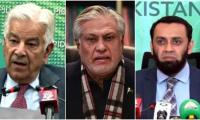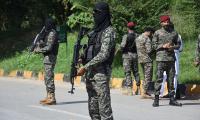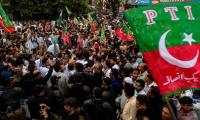Once you are up there, it must be very painful to imagine that one day you will not be the king any longer. It must be even more distressing to think that someone else – an utterly useless person in your eyes – will occupy ‘your’ throne. Someone else will enjoy the company of the fawning courtiers, amusing clowns and obedient servants. How will this country even survive without you? Who will save it when you have taken off your armour?
No wonder then that for the fourth time in Pakistan’s history, a ruling political party is making a concerted effort to establish single-party hegemony, using similar tools and techniques. Will the PTI succeed where three Muslim Leagues and one PPP failed miserably, inflicting grievous harm on themselves, the democratic order and society in the process?
Before we begin the story of the four parties and their botched attempts to rule forever, let’s start with one simple classification of political parties to make things more clear. In political science, it is notoriously hard to categorize political parties. The following classification, based on a simple dichotomy, looks at the origin of political parties and how they transform over time.
Political parties originate either in the legislature or in the civil society. Let’s call them top-down and bottom-up parties. Top-down parties are formed when legislators, or electables, join hands to form a political party and pick one of them as their leader. Bottom-up parties are formed when a leader, or a group of leaders, forms a party and mobilizes the people to win popular support.
However, the relationship between the two types is a dynamic one, as a party can change shape with time. As time passes, a top-down party may succeed in mobilizing the masses and winning public support or a mass party may degenerate into an alliance of the elite groups, losing touch with the people. Generally, most parties in the liberal, non-ideological framework tend to move towards becoming catch-all parties by trying to win support from a diverse vote base and socio-economic groups.
The Pakistan Muslim League, the party that founded Pakistan, started its journey as a top-down party as representatives of the Muslim elite from a large part of India joined hands to form their own party in 1906 and elected His Highness Aga Khan as their first leader. Under Jinnah, the Muslim League was able to win huge mass appeal and became a different kind of party altogether.
Yet after the formation of Pakistan, the Muslim League regressed into a top-down party. Many members in the first legislature had no constituency in the country as they had migrated from India. The dominant elite of West Pakistan were also afraid of the majority population residing in East Pakistan, and were therefore scared of losing power through the democratic process. Instead of extending the mass appeal and cultivating an open democratic environment, the Muslim League sought to achieve the single party hegemony and suppress smaller parties and critical voices.
This is how C R Aslam, a leading communist leader in Punjab described the situation during an interview. “After partition, Muslim Leaguers would not allow anyone else to hold a rally or a demonstration. Jamaat-e-Islami’s Maulana Maududi was also very annoyed with this situation. He said to me, ‘Think of something.’ I spoke to Ferozuddin Mansoor and then the first demonstration was held in 1948 in Mochi Gate. This rally was a joint Jamaat and Communist Party of Pakistan rally. On the stage, Ferozuddin Mansoor (communist leader) and Maulana Maududi sat together.”
This event shows, on the one the one hand, the spirit of accommodation inherent in Pakistan’s democratic culture and, on the other, that even water and fire can mix when political parties face an existential threat. Both of these spirits have thwarted any attempt at single-party domination again and again.
The internal contradictions of the Muslim League proved its undoing after it had lost the pulse of the people. Ayub Khan assumed power in 1958 with an axe in his hand. Political parties and politicians were his first and foremost target. Through early executive orders and through a notorious law titled the Elective Bodies (Disqualification) order (EBDO), he outlawed political parties and banned hundreds of politicians. Initiating the narrative of accountability, he declared the whole generation of Pakistan’s founding fathers corrupt and banned them from elective offices.
In 1962, Bengali leaders in the Awami Muslim League and the Krishak Sramik Party (KSP) rebelled against the ban on the political parties. Their campaign forced Ayub Khan to legalise parties again. At the same time, he formed his own King’s party by factionalizing whatever was left of Jinnah’s party. Ayub named his party the Convention Muslim League and became its chairman a year later. The Convention Muslim League contested the presidential election in 1965. These elections were rigged thoroughly to defeat Mohtarma Fatima Jinnah and ensure Ayub’s victory. The Convention Muslim League could not survive beyond Ayub’s regime.
The Pakistan People’s Party was the first truly bottom-up, civil society based party in Pakistan that emerged as a result of public mobilization by a charismatic political leader – Zulfikar Ali Bhutto. Once in power, Bhutto also suppressed his political opposition ruthlessly, aiming at single-party hegemony. Some parties were banned and many leaders were imprisoned on charges of treason. However, by suppressing the opposition, Bhutto also orchestrated his own downfall as he ended up uniting his vengeful enemies. A clumsy effort to rig the 1977 election proved the final straw, resulting in mass agitation and Zia’s marital law.
A new top-down party emerged in the non-party assembly formed by Ziaul Haq. Factional fighting within this party gave birth to a new party – the PML-N. The PML-N, under the leadership of Nawaz Sharif, turned out to be the only top-down political party in Pakistan’s history that has been able to reach out to the people and create a large constituency for itself.
During its first two tenures, the PML-N appeared resolved to establish single-party hegemony. Ironically, it invented the current system of accountability that Pervez Musharraf polished and improved. Nawaz Sharif came close to achieving his dream, at least temporarily, before he was ousted in a coup by Musharraf. Benazir’s PPP, on the other hand, was too weak and too beleaguered to make a similar effort and perhaps BB was too much of a democrat as well.
Under Musharraf, the PML-Q emerged as a new obedient, top-down variant of the PML-N. The Chaudharys of Gujrat who had served under Ayub and Zia, were available to serve as foremen at the new project of political engineering. Pervez Musharraf exiled the heads of both major political parties and forced dozens of political leaders and legislators to change their loyalties. Unfortunately, the glory of the PML-Q ended with Musharraf, though the Chaudharys remain at the king’s service.
The PTI is a bottom-up party that enjoys the support of a vibrant and influential section of society. However, it shows many attributes of the PML-Q as well. A large number of electables that flocked to its stables a short time before the elections have given it a hybrid quality of the two types we have discussed. Its support base is also limited by class and ethnicity.
Imran Khan has vowed that he will not spare a single one of the opposition leaders. Political parties are under a lot of stress and parliament remains dysfunctional. There are also clear signs of the opposition closing its ranks. The worsening economic situation may prove a deadly weapon in the hands of leaders Imran Khan wants to eliminate. Will Imran Khan succeed where Ayub, Bhutto, Nawaz Sharif and Musharraf failed? We know that charisma and coercion is not enough to institute a system based on single-party hegemony. It requires a different kind of society and different kind of skill altogether. Imran Khan may not have the last laugh in the zero-sum game he has chosen to play.
The writer is an anthropologist and development professional.
Email: zaighamkhan@yahoo.com
Twitter: @zaighamkhan
Data, today, defines how we make decisions with tools allowing us to analyse experience more precisely
But if history has shown us anything, it is that rivals can eventually unite when stakes are high enough
Imagine a classroom where students are encouraged to question, and think deeply
Pakistan’s wheat farmers face unusually large pitfalls highlighting root cause of downward slide in agriculture
In agriculture, Pakistan moved up from 48th rank in year 2000 to an impressive ranking of 15th by year 2023
Born in Allahabad in 1943, Saeeda Gazdar migrated to Pakistan after Partition







